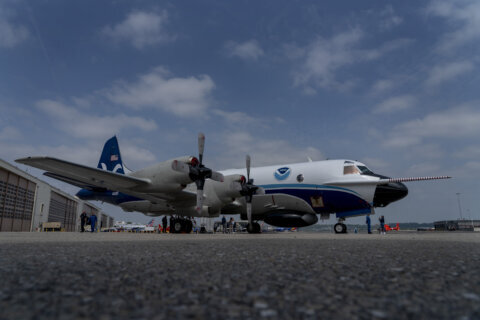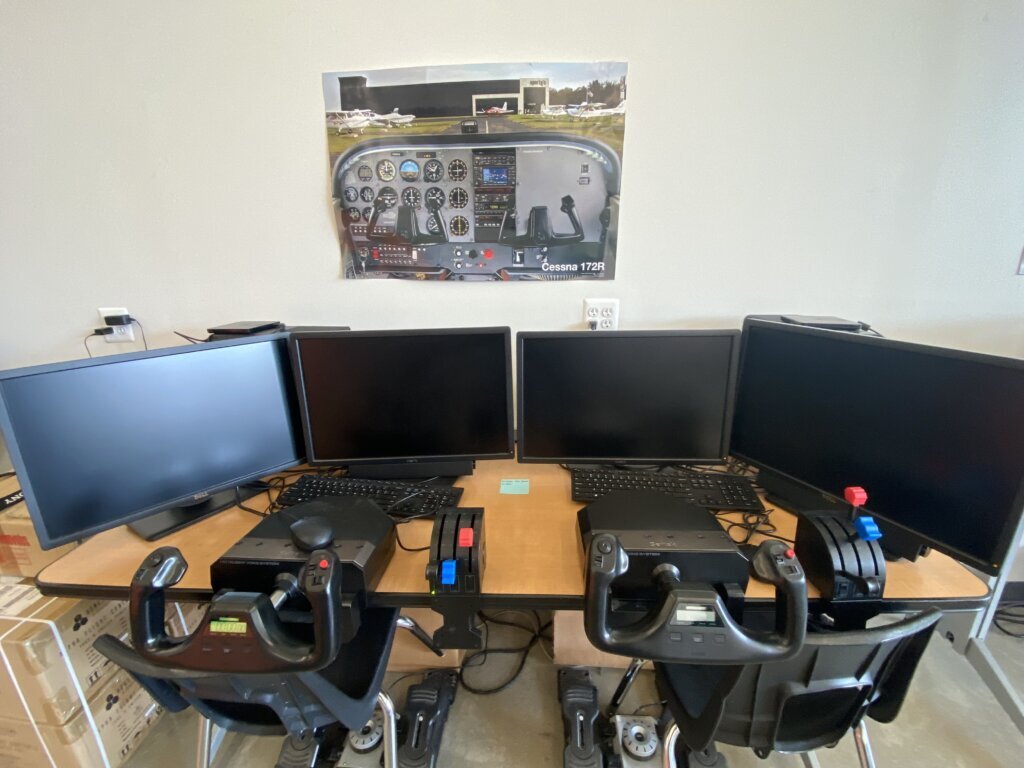
While most people are told to keep their distance from powerful storms, Capt. Rebecca Waddington’s job is to fly right into them. Like, directly through them.
Waddington is part of NOAA’s team dubbed the Hurricane Hunters. She’s seen a lot — but as she stood inside the aerospace engineering classroom designed like an airplane hangar at DuVal High School in Lanham, she was in awe.
“There is a flight simulator behind me,” said Waddington, a pilot with NOAA Corps. “I wish I had a flight simulator in high school. I think this is amazing, the way they’re encouraging the students to just branch out and try different things.”
Waddington was at DuVal for NASA-NOAA Day, which sees reps from the two agencies, as well as some local private sector companies, visit the school and talk with students in the school’s aerospace engineering program.
It gives those agencies a chance to talk with students and inspire them to keep going down an aerospace engineering path — but leaders from those agencies also acknowledged it’s a recruiting event, aimed at luring some of the best and brightest students into full-time jobs at federal agencies based right in their home county.
“If you talk to these students, you’ll appreciate how strong this program has served them in terms of understanding the engineering design process, aerospace and avionics engineering,” said Nipa Shah, NASA Goddard’s deputy director for technology and research investments. “They are absolutely poised for college and for the workforce. ”
Many of the day’s presentations focused on climate change and the various jobs that help study weather and climate around the world. That’s why Waddington was there to talk about her path to becoming a Hurricane Hunter.

“Sometimes it’s the weaker storms that knock you around more because they’re still developing,” she said, talking to WTOP about flying through storms. “You get into a Category 5, and it’s relatively stable. We have onboard meteorologists that keep us safe, they pick out the safest way in and out of the storm. So when you have a very developing storm, you don’t have those clear pictures on the radar, you can get knocked around a little bit more.”
Her path to becoming a Hurricane Hunter was about as meandering as some of the storms she flies through. It included time as an oceanographer, and even led to an extended excursion to Antarctica with other women involved in STEM careers. It helped reinforce the wide variety of jobs out there available to students like the ones at DuVal.
“This is the future of our workforce, both in NOAA and NASA,” said Ajay Mehta, Director of the Office of Observations with NOAA’s National Weather Service, which has offices in Suitland and College Park. “The work they’re doing here is tremendous. It’s actually aligned very well with what we’re trying to do. It combines the science, the engineering, the aviation and the aeronautics. And, you know, what NOAA does is fly satellites, take the data from the satellite, create weather forecasts for the public every day. So these kids could be the future of both NOAA and NASA.”
The event Tuesday comes just days after the program at DuVal was cited by the American School Board Journal as a grand prize winner of the MAGNA award, given to innovative learning programs around the country. The program at DuVal was one of three grand prize winners nationwide.
“This is really taking off,” said Maryland Rep. Glenn Ivey, who was also in attendance. “And the aviation aeronautics pieces is critical, for this time, right now.”
Ivey also noted that bridge design learning has been happening at the school for a while now, and said that when things calm down at the Key Bridge, he hopes to someday coordinate a meeting between the students and those tasked with rebuilding it.
“You’ve got things where kids who might be interested in aviation or aerospace engineering, can actually test the waters and get a sense of it,” Ivey said. “And if they like it, they get a huge head start over 99% of the other students in the country before they get to college.”
A similar sentiment was echoed by Shah, who said this program puts students at DuVal 10 steps ahead of most other high school students with a similar interest.
“That is our future. It’s our future scientists. It’s our future engineers,” she said. “They are going to be solving the problems of tomorrow, and we’re very excited to support it.”
Get breaking news and daily headlines delivered to your email inbox by signing up here.
© 2024 WTOP. All Rights Reserved. This website is not intended for users located within the European Economic Area.









